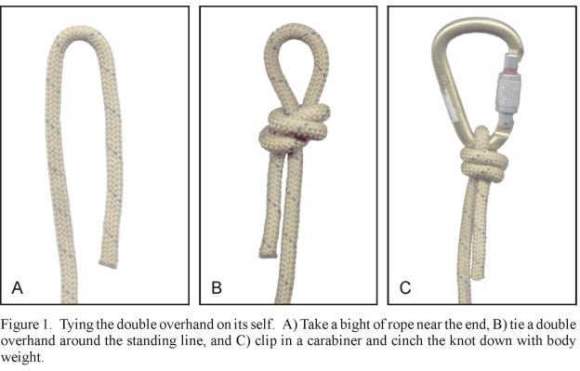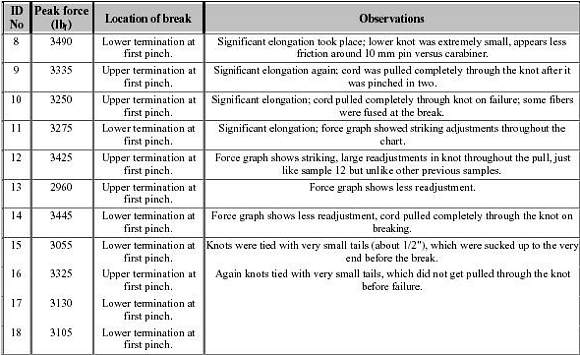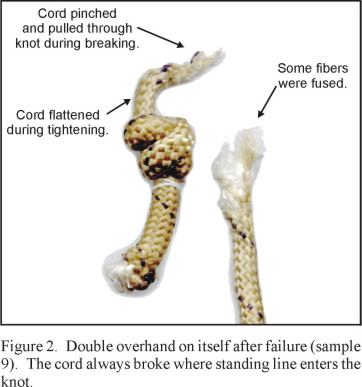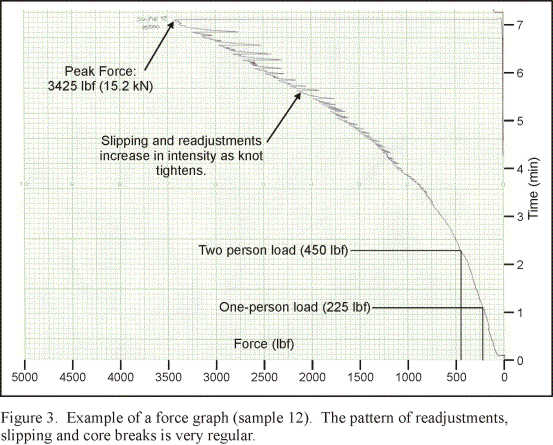Slow-Pull Testing Of The "Double Overhand On Itself" Tie
by Collin O'Neill
Introduction
Over the past few years of my caving experience I have witnessed several cavers using an unconventional knot on the terminations of their cow's tails. I tied the knot on my own while searching for a termination that would grab a carabiner better than the figure eight on a bight, and soon afterward noticed others using the same knot. When questioned about its use, few of the knots users knew about the safety of the knot or its practical applications. This knot can be best described as a double overhand on itself (DOI) or more obtusely as a half double overhand or half fisherman knot. The nomenclature could be confusing and admittedly is not adequate, but for this paper I will use the double overhand on itself because it is the most descriptive of the three. One ties it by taking a bight of rope, and tying a double overhand with the short end back onto the standing line (Figure 1). A carabiner or other anchor point is placed through the bight and the knot is set by dressing the double overhand portion and tugging on the standing line to cinch it against the carabiner.

Although I used this knot for several years, I've always wanted to know exactly how strong this knot is! It has many advantages for a cow's tail termination. It is compact and creates a sturdy grasp when handling a carabiner; it has a low gain, and it is easy to inspect. The knot also has other uses, such as a termination for a quick-attachment safety (QAS), pre-tensioned back-tie (similar to a trucker's hitch), load-release hitch for rescue use or a termination on a piggyback haul system. In my experience, the knot handles repeated loading and unloading well, provided it is properly dressed and set. Like the double overhand bend (a.k.a. fisherman's knot), the double overhand on itself can be difficult to untie. However, taking the carabiner out of the bight causes the knot to fall apart.
This study represents a test of the slow-pull breaking strength of ten samples of this knot tied with 8 mm prusik cord, similar to cord used on cow's tails. Although the methods used do not strictly match any federal testing, and they were completed using older (but unused) cord, the results offer a great start into understanding this knot.
Methodology
The cord used for this test was 8 mm prusik cord manufactured by CMC Rescue, Inc. and purchased in either 1995 or 1996. It was originally tied into prusik loops, but the cord proved to be too stiff for use as prusik loops in rescue systems, especially after a few uses. The unused loops were untied and stored, and later donated for testing by the San Bernardino Sheriff's Cave Rescue Team. It was always stored in either a storage shelf away from chemicals and sunlight, or in a private garage, also away from chemicals and sunlight. The manufacture's rated breaking strength of the cord, calculated as the mean of samples tested according to Federal Test Standard 191A, Method 6016 minus three standard deviations, was 2875 lbf (12.8 kN).
The machine used for the slow-pull strength testing was an Instron Universal Testing Instrument model TT-CL at the University of California, Riverside College of Engineering. The machine pulled the samples apart at a rate of 2" per minute (5.08 cm/min). Forces were plotted on a paper strip 10" wide with a pen plotter.
The top end of each sample was a DOI tied over a steel D-shaped Stubai carabiner. Instead of a round cross-section, the Stubai carabiner had a T-shaped rod, and the D-shaped bends offered a simulation of the knots use in the real world. The bottom end was also tied with a DOI, but this time over a pin 3/8" (9.5 mm) in diameter, offering a comparison between the breaking characteristics of the knot over a carabiner versus a cylindrical attachment point. In practical use, it was necessary to use the DOI on both ends because a figure eight on a bight and a clove hitch both proved to be weaker than the DOI on the first tests! Both knots were dressed and set properly, but tails were only 1" long in order to conserve rope.
Eleven samples were pulled on July 25, 2000. After breaking, each sample was issued a number and stored for later study. As an afterthought, five samples were marked to measure the amount of cord pulled through the knot after it readjusted. It became apparent early on that this knot stretches significantly.
Results
The eleven samples failed between 3490 lbf (15.5 kN) and 2960 lbf (13.2 kN), a range of 530 lbf (2.4 kN). The average breaking strength was 3254 lbf (14.5 kN). The minimum breaking strength of this knot on this cord could be expressed as the average minus three standard deviations, equaling 2737 lbf (12.2 kN). Overall, this knot reduced the rated breaking strength of the cord by only 5%. However, this comparison is flawed because a control of the cord was not tested in conjunction with the DOI knots. It is possible that the strength of the cord in our tests may be higher than the manufacturer's rated breaking strength.

More interesting than the numbers, and the high strength of the knot during slow pull tests, is the behavior of the knot as it tightens to failure. Five of the eleven tests broke at the upper knot, while six of the tests broke at the lower knot, around the 3/8" diameter (9.5 mm) pin. It appears the shape of the attachment point had little to do with the knot strength.
 The double overhand on itself adjusted and slipped noticeably. As the knot was pulled tighter, the cord slipped completely through the knot, pulling the tail about 1/2" (1.76 cm) into the knot. The standing line elongated significantly, as much as 17.2" (18.3 cm). Eventually the knot was tight enough that the tail was pinched. All of the samples failed at the point where the standing line enters the knot; a breaking characteristic similar to figure eights, bowlines and butterfly knots (Figure 2). Although strands within the core were sometimes heard breaking (mirrored by drops in force on the chart), the rope did not appear damaged where it bent over the carabiner or pin. The breaking of the knot fused some of the fibers in most cases, indicating a brief temperature jump in excess of 250 °F (482 °C; the temperature at which nylon becomes sticky).
The double overhand on itself adjusted and slipped noticeably. As the knot was pulled tighter, the cord slipped completely through the knot, pulling the tail about 1/2" (1.76 cm) into the knot. The standing line elongated significantly, as much as 17.2" (18.3 cm). Eventually the knot was tight enough that the tail was pinched. All of the samples failed at the point where the standing line enters the knot; a breaking characteristic similar to figure eights, bowlines and butterfly knots (Figure 2). Although strands within the core were sometimes heard breaking (mirrored by drops in force on the chart), the rope did not appear damaged where it bent over the carabiner or pin. The breaking of the knot fused some of the fibers in most cases, indicating a brief temperature jump in excess of 250 °F (482 °C; the temperature at which nylon becomes sticky).
The force chart illustrates an exponential increase of force as the knot adjusted and tightened on its self. As the knot approached failure, momentary slipping of the various bends caused the force to jump predictably (Figure 3).
Interpretations
This experiment is esoteric, given the slim chances of a caver pulling on his cow's tail in excess of 2737 lbf (12.2 kN). However, it is useful because it measured the strength of this knot on a commonly used cord. The original concern was that this knot may be somehow very weak, but instead it appears to be stronger than other knots in the same cord. During preparation for testing, a sample was pulled in which a DOI was tied on one end and a figure eight on a bight on the other. The figure eight on a bight failed before the DOI. Likewise, a clove hitch failed before its DOI counterpart. The knots strength appears to come from its ability to readjust until it is constricts itself to pieces. Although it was not measured, the DOI stretched significantly more than its figure eight or clove hitch counterparts. Of the three, the clove hitch had the least cord to adjust and failed earlier than the figure eight or DOI. Also, the breaking point on the clove hitch was cleaner and had more fused fibers than the others.
Although testing of this knot is far from complete, my conclusion is that it is an excellent choice for a cow's tail or QAS termination. It provides the above-mentioned advantages of low gain, compactness, ease of inspection and easy grasping point, and the knot is assured to fail after other critical components start to fail. If forces great enough to break this knot were applied, they would be caused only be negligence.

Further Studies
As useful as this study was, it misses an important point: knowing how this knot performs under a shock force is more important than its slow-pull strength. One function of the cow's tail is to catch a climber when he or she is attached to an anchor over a fall hazard. Typically, the attachment point is above the harness attachment, yielding a low fall factor should the climber slip and fall. However, it is common to be attached at the same level of the anchor, and, although not recommended, I have witnessed many cavers climbing above their anchors, potentially incurring a fall factor of 2! So, does this knot stand up to falls? My guess is that its steady elongation characteristics make it a good energy-absorbing knot. Does the cord adjust similarly in a dynamic event? Probably not, and it may have less time to stretch, therefore dissipating less energy than observed in the slow-pull tests. This may be true of most knots.
In any fall, the rope dissipates kinetic energy of the falling mass. Ropes stretching less absorb less energy, resulting in much higher peak forces than high-stretch ropes. That is precisely the reason climbers love high-stretch rope! It is also for this reason that low-stretch cords such as Spectra and Kevlar should never be used if the caver wishes to maintain a 2:1 safety factor during dynamic events (i.e. slipping down a pit). But energy is dissipated throughout the entire system. In the case of a cow's tail, a falling caver stretches the standing line and tightens two knots, resulting in even lower peak forces. If one knot stretches more than most, which I suspect is the case of the double overhand on itself, it will provide greater energy dissipation and result in lower peak forces.
There are still other problems with this study that must be considered. First, the cord tested was older and no doubt did not allow the testing method to isolate the behavior of this knot completely. Second, a control test was not performed. Ideally, this test would use new 8 mm cord from one coil, and a control would consist of testing the strength of the cord itself according to federal standards yet on the same machine. Third, the correct number of samples to yield statistically significant results should be determined and followed. In this experiment the number of samples was determined by the time available on the testing machine.
Acknowledgements
I would like to thank the San Bernardino Sheriffs Cave Rescue Team for donating cord used for testing, and Paul Stovall and the UCR College of Engineering for donating the use of their testing machine.Additional equipment was donated by Tad Gallistel and David Owens. Thanks to Paul Stovall, Bryan Lavender and Jeff Lehman for editing comments.
Return to the Top of the Page
Return to the NH #46 Contents Page
Copyright © 2001 Vertical Section of the NSS, Inc. - All Rights Reserved.